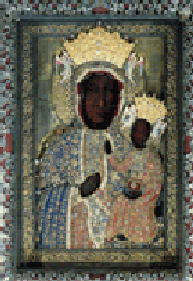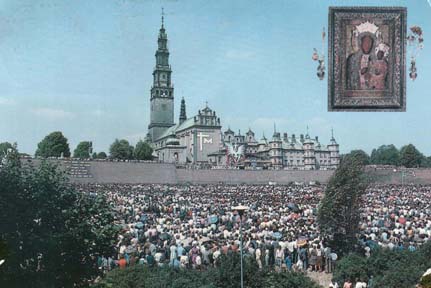| Return to main page |
There is no assignment today. Instead, over this weekend we shall make a two-day trip to the most important of Poland's many pilgrimage centres. Czestochowa is a couple of hours away from here by bus, to the northwest. The Monastery contains an image of the Virgin Mary that is believed to be miraculous, ever since it contributed to the defeat of the Swedish troops in 1655. Marian cults flourished in the generations following this victory and the first coronation of the 'Queen of Poland' took place at Czestochowa in 1717. So you can see, here too religion and national identity have been mixed up together for a long time already. Most Polish children visit this shrine at least once during their school years, and some are brought back again and again. Try to put yourself in their position when you walk around tomorrow, and we are sure you will find plenty of observations to put into your journals.

Figure 36: The big Black Madonna, Queen of Poland
Ania found the monastery much too crowded. It reminded her of a family visit to Canterbury Cathedral in the days before the Anglican Church imposed entrance charges, and she recalled that Canterbury too had once been a major pilgrimage centre. The throng was almost as great as she had experienced the year before when visiting the Sistine Chapel at the Vatican. The brilliant colours of Michaelangelo's ceiling epitomised a style that she had known in humbler copies since childhood. For her these were the trademark colours of Roman Catholicism, she could not imagine it in any other guise. Sure enough, lots of the statues and postcards on sale at Czestochowa matched the images she had seen in Rome. But there were also lots that did not: darker images of faces that seemed artistically crude, yet possessed of an intensity that was lacking in the gaudy Italian styles. Above all there was the miraculous icon itself, the same image that she had seen on the wall of a worker's flat in Nowa Huta a fortnight before. It looked more like a Russian icon than a western work of art.
Meanwhile Tom was following his third party of schoolchildren on the same guided tour, in an effort to 'enter into the mind of the young', as the Professor and Dr. Dylagowa had recommended. Unfortunately none of the groups he walked around with seemed to show any great interest in the objects they saw or the messages they received from their teachers and guides. Perhaps, thought Tom, they were indeed receiving signals that would be indelibly inscribed into their brains for the rest of their lives. But how was he to intercept those signals? He observed some of the children later in an ice cream bar, and the atmosphere could not have been more profane.
The next day was quite different. High mass was celebrated by the local Archbishop, who made repeated reference in his sermon to the visits made to this shrine by Pope John Paul II. The rowdy children from the previous evening were sitting motionless in the pews. They moved their hands in synchrony to their foreheads at the prayer which introduced the Gospel reading. Ania looked studiously at the Polish text for the prayers said at the most mysterious part of the mass. She knew the English version off by heart, but had never before reflected on the meaning of these words. For the first time it dawned on her that an alien visitor from another planet might find this standard Christian Eucharist ritual a rather remarkable one. 'This is my body ...... this is my blood.....' How would she explain these words to an alien? How were they understood by those children? The proportion of the congregation stepping forward to participate in this communion was about the same as she recalled from her parish church in London. She was surprised to see the Professor step forward and receive the host from the Archbishop, in his hand, in the modern way, still rather uncommon in Poland, while Dr. Dylagowa looked at her watch with a hint of irritation.
Ania wondered if their teachers would try to stimulate further discussion about the advantages and disadvantages for the anthropologist of religion in having a faith herself. But they did not. The Professor talked at some length about the history of the monastery and the role of the Church in the nineteenth century struggles to keep Polish identity alive. Dr. Dylagowa talked about how important the Church had been for her own student generation and then in the years of Solidarity, when she was a young Lecturer. She also explained how the position of the dominant Church had changed since the end of communism. 'Some people say that, now Poland is a democracy and a part of Europe again, so our Catholic Church will have to come to terms with a less dominant role in the society: it might become, for example, more like the Catholic Church in France. But in some respects we are more like the Anglican Church in England: we are still very much a national Church!'
When they returned to their minibus Tom saw the schoolchildren once again;
they were back to their former rowdy selves.

Figure 37: The monastery of Czestochowa and its famous icon (inset)
| Return to main page |